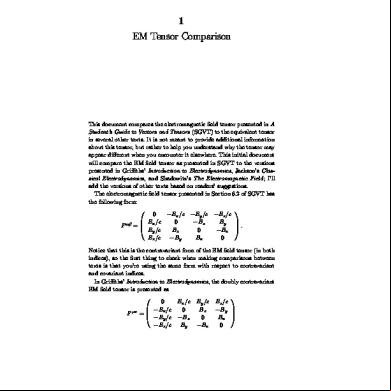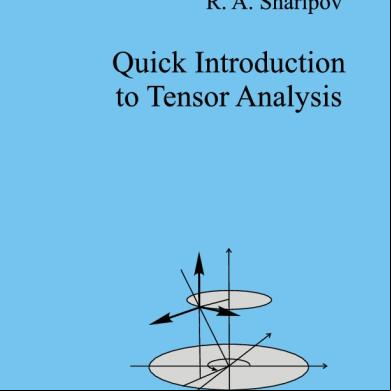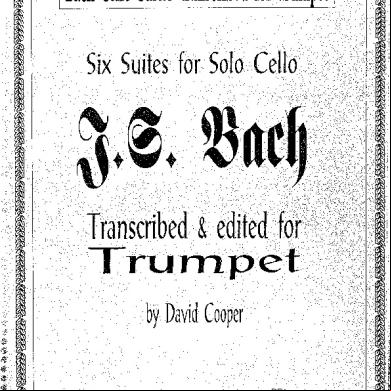Electromagnetic Tensor 264r1x
This document was ed by and they confirmed that they have the permission to share it. If you are author or own the copyright of this book, please report to us by using this report form. Report 3b7i
Overview 3e4r5l
& View Electromagnetic Tensor as PDF for free.
More details w3441
- Words: 800
- Pages: 4
1 EM Tensor Comparison
This document compares the electromagnetic field tensor presented in A Student’s Guide to Vectors and Tensors (SGVT) to the equivalent tensor in several other texts. It is not meant to provide additional information about this tensor, but rather to help you understand why the tensor may appear different when you encounter it elsewhere. This initial document will compare the EM field tensor as presented in SGVT to the versions presented in Griffiths’ Introduction to Electrodynamics, Jackson’s Classical Electrodynamics, and Shadowitz’s The Electromagnetic Field ; I’ll add the versions of other texts based on readers’ suggestions. The electromagnetic field tensor presented in Section 6.2 of SGVT has the following form: ⎛ ⎞ 0 −Ex /c −Ey /c −Ez /c ⎜ Ex /c 0 −Bz By ⎟ ⎟. F αβ = ⎜ ⎝ Ey /c Bz 0 −Bx ⎠ Ez /c −By Bx 0 Notice that this is the contravariant form of the EM field tensor (in both indices), so the first thing to check when making comparisons between texts is that you’re using the same form with respect to contravariant and covariant indices. In Griffiths’ Introduction to Electrodynamics, the doubly contravariant EM field tensor is presented as ⎛ ⎞ 0 Ex /c Ey /c Ez /c ⎜ −Ex /c 0 Bz −By ⎟ ⎟ F µν = ⎜ ⎝ −Ey /c −Bz 0 Bx ⎠ −Ez /c By −Bx 0
2
EM Tensor Comparison
which differs by a minus sign from the version presented in SGVT. This difference is attributable to the fact that Griffiths uses the sign convention of placing a minus sign on the time component and a plus sign on the spatial components of four-vectors, and the opposite convention is used in SGVT. In Jackson’s Classical Electrodynamics, the field tensor is given as ⎛ 0 −Ex −Ey ⎜ Ex 0 −Bz αβ F =⎜ ⎝ Ey Bz 0 Ez −By Bx
doubly contravariant EM ⎞ −Ez By ⎟ ⎟ −Bx ⎠ 0
In this case, the sign convention is the same as that used in SGVT, but the electric-field do not contain the factor of 1/c included in the SGVT version. The reason for this difference is that Jackson uses Gaussian rather than SI units for all chapters after Chapter 10 of the latest (third) edition of his book (that’s what the little “G” means after the chapter headings on the top of the even pages). You can understand the impact of those units by looking at Table 3 in the Appendix of the Jackson text. There he indicates that you should make the following substitutions to convert his equations between systems: in SI E
→
in SI B
→
J in SI
→
E √ in Gaussian system 4π0 mu0 B in Gaussian system 4π √ 4π0 J in Gaussian system
If you make the appropriate conversions in the EM field tensor (as well as in the expression relating the derivatives of the field-tensor elements to the four-current), you can get to Maxwell’s Equations in the same manner described in Section 6.2 of SGVT.
EM Tensor Comparison
3
In Shadowitz’s The Electromagnetic Field, the doubly contravariant EM field tensor is written as ⎛ ⎞ 0 −cBz −cBy −Ex ⎜ −cBz 0 cBx −Ey ⎟ ⎟ F JK = ⎜ ⎝ cBy −cBx 0 −Ez ⎠ Ex
Ey
Ez
0
This appears quite different from the other versions of this tensor discussed above, but notice that a large part of this difference comes about because the electric-field appear in the fourth row and column rather than in the first row and column as in the previous versions. The reason for this difference is that Shadowitz writes four-vectors with the time component in the last position (after the spatial components) rather than in the first position. Additionally, the EM field tensor presented by Shadowitz is essentially c times the EM field tensor in SGVT, so Ex /c in SGVT becomes Ex in Shadowitz, and Bx in SGVT becomes cBx in Shadowitz. To compensate for this difference when deriving Maxwell’s Equations from the EM field tensor, Shadowitz includes a factor of µ0 /0 in front of his four-current (J) term: µ0 ∂Fij = Ji ∂xj 0 so if you pull the multiplicative factor of c out of Shadowitz’s EM tensor and divide it into the four-current term, this becomes µ0 1 µ0 √ Ji = µ0 0 Ji c 0 0 µ20 0 = Ji = µ0 Ji 0 √ where the fact that c = 1/ µ0 0 has been used, making the final expression consistent with the four-current term in SGVT. References Griffiths, D., Introduction to Electrodynamics, Benjamin-Cummings 1999. Jackson, J.D., Classical Electrodynamics, John Wiley 1999. Shadowitz, A., The Electromagnetic Field, McGraw-Hill 1975.
This document compares the electromagnetic field tensor presented in A Student’s Guide to Vectors and Tensors (SGVT) to the equivalent tensor in several other texts. It is not meant to provide additional information about this tensor, but rather to help you understand why the tensor may appear different when you encounter it elsewhere. This initial document will compare the EM field tensor as presented in SGVT to the versions presented in Griffiths’ Introduction to Electrodynamics, Jackson’s Classical Electrodynamics, and Shadowitz’s The Electromagnetic Field ; I’ll add the versions of other texts based on readers’ suggestions. The electromagnetic field tensor presented in Section 6.2 of SGVT has the following form: ⎛ ⎞ 0 −Ex /c −Ey /c −Ez /c ⎜ Ex /c 0 −Bz By ⎟ ⎟. F αβ = ⎜ ⎝ Ey /c Bz 0 −Bx ⎠ Ez /c −By Bx 0 Notice that this is the contravariant form of the EM field tensor (in both indices), so the first thing to check when making comparisons between texts is that you’re using the same form with respect to contravariant and covariant indices. In Griffiths’ Introduction to Electrodynamics, the doubly contravariant EM field tensor is presented as ⎛ ⎞ 0 Ex /c Ey /c Ez /c ⎜ −Ex /c 0 Bz −By ⎟ ⎟ F µν = ⎜ ⎝ −Ey /c −Bz 0 Bx ⎠ −Ez /c By −Bx 0
2
EM Tensor Comparison
which differs by a minus sign from the version presented in SGVT. This difference is attributable to the fact that Griffiths uses the sign convention of placing a minus sign on the time component and a plus sign on the spatial components of four-vectors, and the opposite convention is used in SGVT. In Jackson’s Classical Electrodynamics, the field tensor is given as ⎛ 0 −Ex −Ey ⎜ Ex 0 −Bz αβ F =⎜ ⎝ Ey Bz 0 Ez −By Bx
doubly contravariant EM ⎞ −Ez By ⎟ ⎟ −Bx ⎠ 0
In this case, the sign convention is the same as that used in SGVT, but the electric-field do not contain the factor of 1/c included in the SGVT version. The reason for this difference is that Jackson uses Gaussian rather than SI units for all chapters after Chapter 10 of the latest (third) edition of his book (that’s what the little “G” means after the chapter headings on the top of the even pages). You can understand the impact of those units by looking at Table 3 in the Appendix of the Jackson text. There he indicates that you should make the following substitutions to convert his equations between systems: in SI E
→
in SI B
→
J in SI
→
E √ in Gaussian system 4π0 mu0 B in Gaussian system 4π √ 4π0 J in Gaussian system
If you make the appropriate conversions in the EM field tensor (as well as in the expression relating the derivatives of the field-tensor elements to the four-current), you can get to Maxwell’s Equations in the same manner described in Section 6.2 of SGVT.
EM Tensor Comparison
3
In Shadowitz’s The Electromagnetic Field, the doubly contravariant EM field tensor is written as ⎛ ⎞ 0 −cBz −cBy −Ex ⎜ −cBz 0 cBx −Ey ⎟ ⎟ F JK = ⎜ ⎝ cBy −cBx 0 −Ez ⎠ Ex
Ey
Ez
0
This appears quite different from the other versions of this tensor discussed above, but notice that a large part of this difference comes about because the electric-field appear in the fourth row and column rather than in the first row and column as in the previous versions. The reason for this difference is that Shadowitz writes four-vectors with the time component in the last position (after the spatial components) rather than in the first position. Additionally, the EM field tensor presented by Shadowitz is essentially c times the EM field tensor in SGVT, so Ex /c in SGVT becomes Ex in Shadowitz, and Bx in SGVT becomes cBx in Shadowitz. To compensate for this difference when deriving Maxwell’s Equations from the EM field tensor, Shadowitz includes a factor of µ0 /0 in front of his four-current (J) term: µ0 ∂Fij = Ji ∂xj 0 so if you pull the multiplicative factor of c out of Shadowitz’s EM tensor and divide it into the four-current term, this becomes µ0 1 µ0 √ Ji = µ0 0 Ji c 0 0 µ20 0 = Ji = µ0 Ji 0 √ where the fact that c = 1/ µ0 0 has been used, making the final expression consistent with the four-current term in SGVT. References Griffiths, D., Introduction to Electrodynamics, Benjamin-Cummings 1999. Jackson, J.D., Classical Electrodynamics, John Wiley 1999. Shadowitz, A., The Electromagnetic Field, McGraw-Hill 1975.










